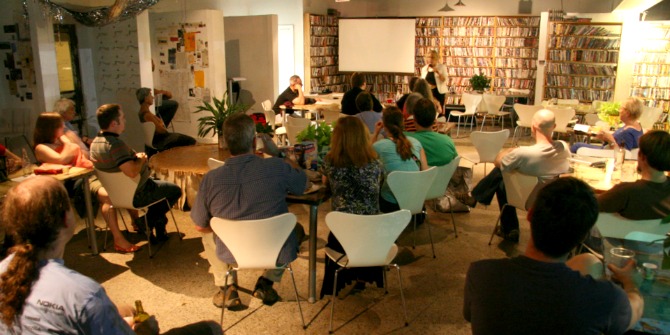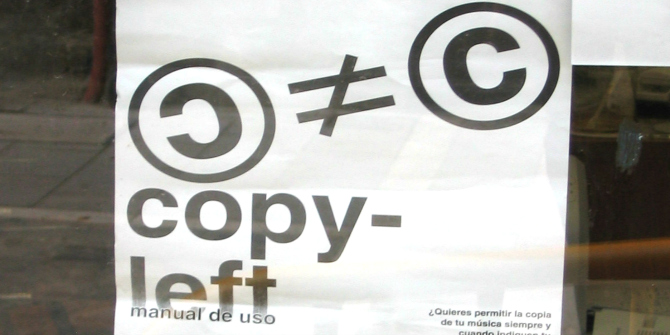In Being a Scholar in the Digital Era: Transforming Scholarly Practice for the Public Good, Jessie Daniels and Polly Thistlethwaite explore how digital media can be used to support scholarship and teaching and also further the pursuit of social justice. Paul Webb recommends this fascinating book for showing how digital scholarship can help generate robust research with genuine impact and can enable the convergence of academia, activism and journalism in productive ways.
This review originally appeared on LSE Review of Books and is published under a CC BY-NC-ND 2.0 UK license.
Being a Scholar in the Digital Era: Transforming Scholarly Practice for the Public Good. Jessie Daniels and Polly Thistlethwaite. Policy Press. 2016.
 The New York Times columnist, Nicholas Kristof, has described professors as ‘some of the smartest thinkers on problems at home and around the world’ who nonetheless, in the majority of cases, ‘just don’t matter in today’s great debates’. Provocative? Perhaps. Anti-intellectual? I don’t believe so; although one could perhaps more charitably argue that some academics may have inadvertently marginalised themselves, either because they don’t know enough about alternative modes of digital media – podcasts, blogs, twitter, altmetrics and so forth – or because they reject these modes of communication due to the association between digital technology and the marketisation of higher education.
The New York Times columnist, Nicholas Kristof, has described professors as ‘some of the smartest thinkers on problems at home and around the world’ who nonetheless, in the majority of cases, ‘just don’t matter in today’s great debates’. Provocative? Perhaps. Anti-intellectual? I don’t believe so; although one could perhaps more charitably argue that some academics may have inadvertently marginalised themselves, either because they don’t know enough about alternative modes of digital media – podcasts, blogs, twitter, altmetrics and so forth – or because they reject these modes of communication due to the association between digital technology and the marketisation of higher education.
For anyone who falls into either of these categories, a possible solution could be to read Jessie Daniels and Polly Thistlethwaites’s new book, which argues that scholars should move from scholarly practices associated with the pre-internet age to what they characterise as ‘digital scholarship’. What is meant by this is the subject of Being a Scholar in the Digital Era, but in broad terms the authors advocate open models of knowledge production and dissemination between academic and non-academic partners using the most appropriate digital technologies to maximise the impact and dissemination of research.
The book is most definitely not a technical treatise, which is a point in its favour if the intention is to persuade readers who may be intimidated by digital technology to avail of these tools in their own work. What they do instead is describe how digital technologies have been used in their own and others’ research, providing copious references for readers who want to know the technical detail.
But why should scholars become ‘digital scholars’? In short, what’s the problem? For Daniels and Thistlethwaite, the current social science publishing landscape is populated by a small sub-set of publishers, university presses with highly specialist and therefore very small print runs and similarly specialist journals that are not accessible to anyone without access to a university library. Moreover, such a model of publication, with its infinitesimally small readership, is no longer sensible or rational in an age of ‘comparatively cheap, digital production and distribution of scholarly work’ (4).
 Image Credit: (Joan Shaffer CC BY SA 2.0)
Image Credit: (Joan Shaffer CC BY SA 2.0)
In contrast, what the authors envisage is a situation where academics use digital platforms to co-produce research with community activists and communications professionals like journalists, film and documentary makers. One particularly noteworthy example that the authors refer to is Morris Justice: A Public Science Project in the Bronx, New York City, where researchers worked with residents to ‘create an active social media campaign in solidarity with court cases, legislation, and community organizing’ (23). What is particularly noteworthy is the way in which the Morris Justice project and an artists’ collective employed ‘spectacular messaging’ using a light projector to project survey results onto an apartment building (23).
One interesting consequence of Daniels and Thistlethwaites’ approach is that the ubiquity of digital publishing platforms like WordPress means that the traditional litmus test of research quality is no longer publication but the response produced by the readership (4). But will opening academic work to open peer review produce research that is rejected by more conventional academics? Daniels and Thistlethwaite don’t believe so, and they buttress their case with reference to a number of persuasive examples. They refer, for example, to Kathleen Fitzpatrick’s book on Planned Obsolescence, which was published in draft form in open peer review before being conventionally published by an academic press (3).
In a similar vein, the authors contend that it is possible to conduct research which is academically respectable, has impact on policy and a wide readership. One only has to recall that the ‘Reading the Riots’ study of the summer riots in England in 2011 – which Daniels and Thistlethwaite describe as ‘a hybrid form of social science research and investigative journalism’ (25) – had a combined radio and television audience of over 30 million people on ‘first phase launch day’ and that the study led to the publication of conventionally peer-reviewed publications too (Newburn 2015).
Unsurprisingly, the authors are particularly persuasive advocates of digital scholarship when they concentrate on learning gained from their own involvement with the recently concluded JustPublics@365: a project designed to bring academics, journalists and activists together to ‘address social justice issues through the use of social media’ (18). Beginning in January 2013 at the Graduate Center, City University of New York (CUNY), the JustPublics@365 team members aimed to create information that had an impact outside of academia but which was robust from a scholarly perspective. Referring to their work across areas as diverse as ‘stop and frisk’ (31) the ‘public health alternatives to criminalising drug use’ (32) and disability studies (35), Daniels and Thistlethwaite describe how they used podcasts, project blogs and downloadable eBooks to ‘open up knowledge’ beyond the academy. One particularly noteworthy example is the Social Media Toolkit, which will be of use to academics who may, as the project website says, be ‘perplexed about how to share their research’ with people beyond the university.
The authors are not, however, mere utopians who regard digital technology as an unqualified blessing. On the contrary, they argue that tools like massive open online courses (MOOCs) have not delivered on their potential to open up learning to students without a history of prior educational attainment (39-48). Moreover, they are also fully aware of the link between impact measurements and the rise of ‘audit culture’ (115).
This is an excellent book that offers a concise and well-written description of how digital technology has been used to produce robust and genuinely impactful research. The book is short and, in spite of the fact that its focus is on digital scholarship in North American contexts, it will appeal to anyone who has been inspired by scholar-activists like W.E.B. Du Bois or C Wright Mills (24), but who would like to know how to become a scholar-activist in the digital era. The authors are also particularly good when charting the ‘convergence’ between disciplines and practices – academia, activism and journalism – that have been conventionally regarded as discrete. All things considered, this book is a fascinating and accessible read.
Paul Webb is a Research Manager at Praxis Care, Belfast, Northern Ireland. Read more by Paul Webb.
Note: This review gives the views of the author, and not the position of the LSE Impact Blog, or of the London School of Economics.







